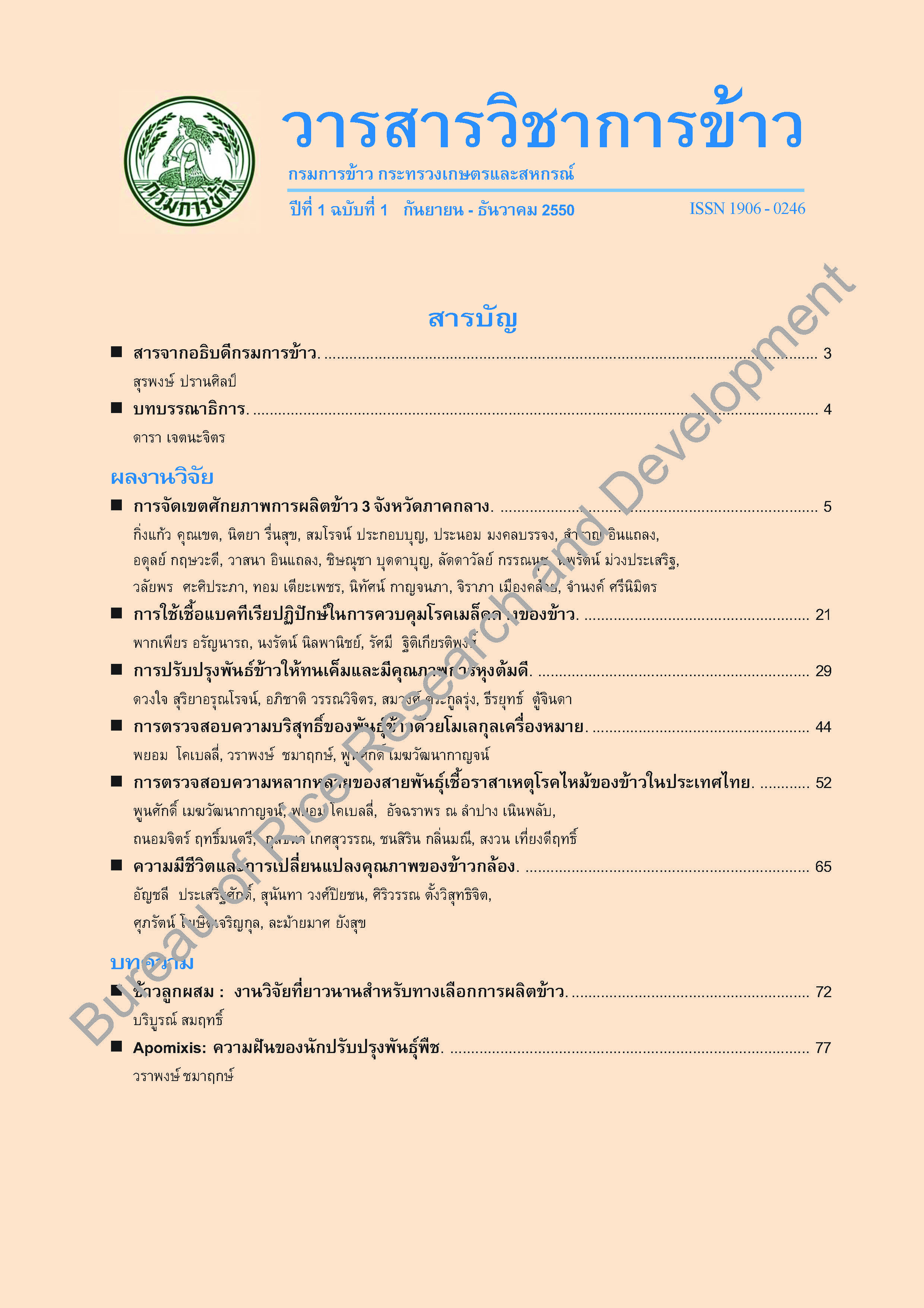การปรับปรุงพันธุ์ข้าวให้ทนเค็มและมีคุณภาพการหุงต้มดี
Main Article Content
บทคัดย่อ
การปรับปรุงพันธุ์ข้าวให้ทนต่อสภาพดินเค็มในประเทศไทยได้มีการดำเนินการมานับสิบๆ ปี พันธุ์ที่ได้ถึงแม้จะมีความทนเค็มในระดับสูง แต่มักมีคุณภาพเมล็ดและการหุงต้มไม่ดี ในปี พ.ศ. 2544 จึงมีการริเริ่มปรับปรุง พันธุ์ข้าวขาวดอกมะลิ 105 ซึ่งเป็นพันธุ์ข้าวที่มีคุณภาพเมล็ดดี มีความหอม ให้ทนเค็ม โดยวิธีการทางเทคโนโลยีชีวภาพ หรือโดยใช้โมเลกุลเครื่องหมายช่วยในการติดตาม เพื่อให้เกิดความแม่นยำในการคัดเลือกมากยิ่งขึ้น ดำเนินการผสมพันธุ์แบบการผสมกลับ (backcross) มีสายพันธุ์แท้ที่มีลักษณะความทนเค็มจากพันธุกรรมของพันธุ์พอคคาลี่ (Pokkali) ที่เกิดจากการผสมพันธุ์ระหว่าง IR29 และ Pokkali จำนวน 2 สายพันธุ์ คือ FL496 และ FL530 เป็นพันธุ์ ถ่ายทอดลักษณะความทนเค็ม และใช้พันธุ์ขาวดอกมะลิ 105 เป็นพันธุ์รับลักษณะความทนเค็ม เมื่อได้ลูกผสมชั่วที่ 1 ของคู่ผสมระหว่าง ขาวดอกมะลิ 105 x FL496 และ ขาวดอกมะลิ 105 x FL530 จึงผสมกลับไปยังขาวดอกมะลิ 105 ได้ลูกผสมกลับครั้งที่ 1 ชั่วที่ 1 (BC1F1) ใช้โมเลกุลเครื่องหมายช่วยในการคัดเลือก BC1F1 ในการผสมกลับครั้งที่ 2 โมเลกุลเครื่องหมายที่ใช้ในการติดตามลักษณะความทนเค็ม ได้แก่ RM140, B1.1-1 และ B1.1-11 ซึ่งครอบคลุมตำแหน่ง ที่ควบคุมลักษณะทนเค็มบนโครโมโซม 1 เป็นระยะ 33 เซนติมอแกน (cM) และใช้โมเลกุลเครื่องหมาย RM00 และ 10L03FW สำหรับติดตามลักษณะความนุ่มและความหอม เมื่อได้ลูกผสมกลับครั้งที่ 2 ชั่วที่ 2 (BC2F2) และลูกผสม กลับครั้งที่ 2 ชั่วที่ 3 (BC2F3) นำไปตรวจสอบการถ่ายทอดลักษณะทางพันธุกรรมจากพันธุ์ขาวดอกมะลิ 105 พบว่า ลูกผสม BC2F1 มีพันธุกรรมของขาวดอกมะลิ 105 67.2-92.3% และ BC2F3 มีพันธุกรรมของขาวดอกมะลิ 105 72.45-95.92% มีคุณภาพการหุงต้มเหมือนขาวดอกมะลิ 105 ส่วนลักษณะทางการเกษตรพบว่า 81 จาก 90 สายพันธุ์มี จำนวนเมล็ดต่อรวงมากกว่า 47 สายพันธุ์มีน้ำหนัก 1000 เมล็ดมากกว่า และ 74 สายพันธุ์ที่ให้ผลผลิตสูงกว่าขาวดอกมะลิ 105 แสดงว่าวิธีการทางเทคโนโลยีชีวภาพสามารถช่วยในการปรับปรุงพันธุ์ข้าวทนเค็มให้มีลักษณะการหุงต้มที่ดีขึ้นได้
Article Details
เอกสารอ้างอิง
Ahn, S.N., C.N. Bollich and S.D. Tanksley. 1992. RFLP tagging of a gene for aroma in rice. Theor. Appl. Genet. 84 : 825-828.
Akbar, M., T. Yabuno and S. Nakao 1972. Breeding for saline - resistant varieties of rice. 1 Variability for salt tolerance among some rice varieties. Japanese Journal of Breeding 22 : 277-284.
Allard, R.W. 1960. Principles of Plant Breeding. Wiley, New York. 150 p.
Asch, F., M. Dingkuhn, K. Dorffling and K. Miezan. 2000. Leaf K/Na ratio predicts salinity induced yield loss in irrigated rice. Euphytica 113 : 109-118.
Babu, R., S.K. Nair, B.M. Prasanna and H.S. Gupta. 2004. Integrating marker assisted selection in crop breedingprospects and challenges. Current Science 87(5) : 607-619.
Barr, H.D. and P.E. Weatherley. 1962. A re-examination of the relative turgidity technique for estimating water deficit in leaves. Aust. J. Biol. Sci. 15 : 413-428.
Buttery, R.G., L.C. Ling, B.O. Juliano and J.G. Turnbaugh. 1983. Cooked rice aroma and 2-acetyl-1-pyrroline. J. Agric. Food Chem. 31 : 823-826.
Garland, S., L. Lewin, A. Blakeney and R. Reinke. 2002. PCR-based molecular markers for the fragrance gene in rice (Oryza sativa L.) Theor. Appl. Genet. 101 : 364-371.
Gregorio, G.B., D. Senadhira and R.D.Mendoza. 1997. Screening rice for salinity tolerance. pp. 2-23. In: IRRI Discussion Paper Series No. 22, International Rice Research Institute, Manila, P.O. Box 933, 1099, Philippines.
Hospital, F., C. Chevalet and P. Mulsant. 1992. Using markers in gene introgression breeding programs. Genetics 132 : 1119-1210.
IRRI. 1996. Standard Evaluation System for Rice. 4th edition. International Rice Research Institute, Manila, P.O. Box 933, 1099, Philippines. 35 p.
Juliano, B.O. and A.A. Perdon. 1975. Gel and molecular properties of nonwaxy rice, Starch-Starke. 27 : 115-120.
Juliano, B.O. and C.G. Pascual. 1980. Quality characteristics of milled rice grown in different countries. International Rice Research Institute. Los Banos, Laguna, Philippines. Paper Series No. 48. 25 pp.
Kapp, L.C. 1974. The effect of common salt on rice production. Arkansas Experimental Station Bulletin 465 : 3-7.
Lanceras, J.C., Z.L. Huang, O. Naivikul, A. Vanavichit, V. Ruanjaichon and S. Tragoonrung. 2000. Mapping of genes for cooking and eating qualities in Thai jasmine rice (KDML105). DNA Research 7 : 93-101.
Lorieux, M., M. Petrov, N. Huang, E. Guiderdoni and A. Ghesquiere. 1996. Aroma in rice : genetic analysis of a quantitative trait. Theor. Appl. Genet. 93 : 1145- 1151.
Netondo, G.W., J.C. Onyango and E. Beck. 2004. Sorghum and salinity : I. Response of growth, water relations and ion accumulation to NaCl salinity. Crop Sci. 44 : 797-805.
Pearson, G.A. 1959. Factors influencing salinity of submerged soils and growth of Caloro rice. Soil Sci. 87 : 198-206.
Stuber, C.W. 1995. Mapping and manipulating quantitative trait in Maize. Trends Genetics 11 : 477-481.
Suriyaarunroj, D., N. Supapoj, T. Toojinda and A. Vanavichit. 2004. Relative leaf water content as an efficient method for evaluating rice cultivars for tolerance to salt stress. Science Asia 30 : 411 - 415.
Wahid, A. 2004. Analysis of toxic and osmotic effects of sodium chloride on leaf growth and agronomic yield of sugarcane. Bot Bull. Acad. Sin. 45 : 133-141.
Yeo, A.R., M.E. Flower and T.J. Flower. 1988. Selection of lines with high and low sodium transport from within varieties of an inbreeding species : rice (Oryza sativa). New Phytologist 110 : 13-19.
Yoshida, S., D.A. Forno, J.H. Cock and K.A. Gomez. 1976. Laboratory Manual for Physiological Studies of Rice. 3rd ed. International Rice Research Institute, Manila, P.O. Box 933, 1099, Philippines. pp. 61-66.
Zhu, G.Y., J.M. Kinet and S. Lutts. 2001. Characterisation of rice (Oriza sativa L.) F3 populations selected for salt resistance. I. Physiological behaviour during vegetative growth. Euphytica 121 : 25-263.

